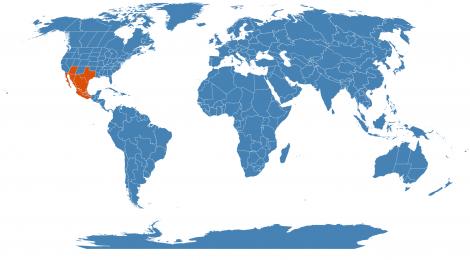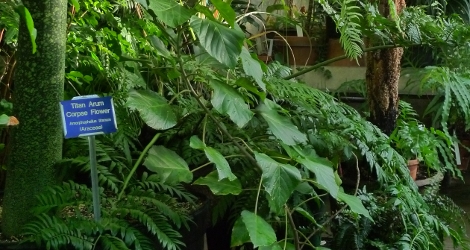Accession Data:
Agave americana L.
- Common Name: Century Plant
- Family: Asparagaceae Juss.
- Country of Origin: eastern Mexico

- Habitat: Original habitat is unknown but it grows wild in Mexico on c
- Description: Leaves in a basal rosette, to 5 feet long, nearly 10 inches wide, gray, curved or reflexed at tip, margin toothed but not horny; inflorescence paniculate, tall; flowers pale yellow, to 3 5/8 inches long, calyx and corolla of a flower (generally used when the two are similar).">perianth segments erect, to 1 1/4 inch long, ovary shorter than perianth. Pollination believed to be effected by bats or moths.
- Uses: The heart of the plant is very rich in saccharine matter and can be eaten when baked. Sweet and nutritious, but rather fibrous. Seed - ground into a flour and used as a thickener in soups or used with cereal flours when making bread. Flower stalk - roasted. Used like asparagus. Sap from the cut flowering stems is used as a syrup or fermented into pulque or mescal. The sap can also be tapped by boring a hole into the middle of the plant at the base of the flowering stem.
Antiseptic. The sap is diaphoretic, diuretic and laxative. An infusion of the chopped leaf is purgative and the juice of the leaves is applied to bruises. The plant is used internally in the treatment of indigestion, flatulence, constipation, jaundice and dysentry. Steroid drug precursors are obtained from the leaves. A gum from the root and leaf is used in the treatment of toothache. The root is diaphoretic and diuretic. It is used in the treatment of syphilis. All parts of the plant can be harvested for use as required, they can also be dried for later use. The dried leaves and roots store well.
People often ask if this is the Agave grown for tequila. Technically, tequila is a type of mezcal, but all mezcals are not tequila. To be a true tequila, it must be derived from Agave tequilana Weber azul, or more commonly known as the Webers Blue variety of Agave tequilana. Most of the mezcal beverages are made from one of 5 or 6 species, of which A. americana is reportedly one.
- IMPORTANT NOTE: Plant Uses are for informational purposes only. EEB Greenhouses assume no responsibility for adverse effects from the use of any plants referred to on this site. Always seek advice from a professional before using any plant medicinally.
- Culture: Requires a very well-drained soil and a sunny position. A monocarpic species, the plant lives for a number of years without flowering but the rosette dies once it does flower. However, it normally produces plenty of suckers during its life and these take about 10 - 15 years in a warm climate, considerably longer in colder ones, before flowering.
Seed - surface sow in a light position, April in a warm greenhouse. The seed usually germinates in 1 - 3 months at 20øc. Prick out the seedlings into individual pots of well-drained soil when they are large enough to handle and grow them on in a sunny position in the greenhouse until thay are at least 20cm tall. Plant out in late spring or early summer, after the last expected frosts, and give some protection from the cold for at least their first few winters. Offsets - potted up at any time they are available. Keep in a warm greenhouse until they are well established.
Accession Data:
- Accession # 198800117
- Source: T&M
- Accession Date: 12-31-1988
- Bench: 2211 - XER:Chihuahuan-Tehuacan Deserts
- Currently: active - healthy
- Qty: 1 confirmed on 04-28-2025
Classification:
- Division: Magnoliophyta
- Class: Liliopsida
- SubClass: monocots
- Order: Asparagales
- SubOrder:
- Family: Asparagaceae
- SubFamily: Agavoideae
- Tribe: Agaveae
- SubTribe:
References (internal):
- EEB Greenhouse Holdings native to: Arizona / Texas / Mexico Central / Mexico Northeast / Mexico Gulf / Mexico Northwest / Mexico Southwest /
References (external):
- Plants For A Future Website
- Hortus Third, LH Bailey Hortorium, 1976
- The Plant List (2013). Version 1.1. Last accessed on Wednesday, January 04, 2017.
- WCSP (2016). World Checklist of Selected Plant Families. Facilitated by the Royal Botanic Gardens, Kew. Last accessed on Wednesday, January 04, 2017.
- Angiosperm Phylogeny Website at MoBot. Last accessed on Tuesday, 03 December, 2019.
data regenerated on Mon, 28 Apr 2025 10:36:19 -0400 [bcm v4.0]
Images:

Additional images for this accession:
Click on thumbnails to enlargeCurrent Accessions in the Asparagaceae
Subfamily Agavoideae
Subfamily Agavoideae
Tribe Agaveae
- Agave americana 'Marginata'

- Agave americana


- Agave attenuata

- Agave cf parryi
- Agave cf stricta
- Agave cf. titanota
- Agave guiengola W/C

- Agave murpheyi

- Agave nizandensis

- Agave parrasana

- Agave parryi

- Agave polianthiflora

- Agave schidigera

- Agave sisalana


- Agave tequilana


- Agave victoriae-reginae

- Agave victoriae-reginae

- Beschorneria septentrionalis


- Furcraea foetida

- Hosta sieboldiana


- Hosta tsushimensis W/C

- Manfreda maculosa

- Polianthes tuberosa

- Yucca glauca

Subfamily Agavoideae
Tribe Anemarrheneae
Subfamily Agavoideae
Tribe Anthericeae
Subfamily Asparagoideae
Subfamily Lomandroideae
Tribe Arthropodium group
Subfamily Lomandroideae
Tribe Cordylineae
Subfamily Lomandroideae
Tribe Lomandreae
Subfamily Nolinoideae
Tribe Convallarieae
- Aspidistra elatior


- Aspidistra grandiflora W/C

- Aspidistra tonkinensis W/C

- Reineckea carnea

- Tupistra kressii W/C


- Tupistra urceolata W/C


Subfamily Nolinoideae
Tribe Dracaeneae
- Dracaena aethiopica

- Dracaena angolensis

- Dracaena angolensis

- Dracaena aubryana

- Dracaena draco

- Dracaena masoniana

- Dracaena parva

- Dracaena pethera var. pulchra

- Dracaena reflexa

- Dracaena reflexa var. angustifolia

- Dracaena singularis
- Dracaena spathulata W/C

- Dracaena spathulata W/C

- Dracaena trifasciata

- Dracaena trifasciata

Subfamily Nolinoideae
Tribe Eriospermeae
Subfamily Nolinoideae
Tribe Nolineae
Subfamily Nolinoideae
Tribe Ophiopogoneae
- Liriope muscari 'Variegata'

- Ophiopogon jaburan Argenteo-marginatus

- Ophiopogon japonicus


- Peliosanthes macrostegia W/C

Subfamily Nolinoideae
Tribe Rusceae
Subfamily Scilloideae
Tribe Hyacintheae
- Camassia quamash

- Hyacinthinae: Leopoldia longipes

- Hyacinthinae: Scilla peruviana

- Massoniinae: Drimiopsis botryoides


- Massoniinae: Drimiopsis maculata


- Massoniinae: Eucomis bicolor


- Massoniinae: Eucomis vandermerwei W/C


- Massoniinae: Lachenalia aloides

- Massoniinae: Lachenalia bulbifera


- Massoniinae: Lachenalia cf. longituba W/C

- Massoniinae: Lachenalia ensifolia


- Massoniinae: Lachenalia rubida

- Massoniinae: Lachenalia unifolia W/C

- Massoniinae: Lachenalia viridiflora


- Massoniinae: Ledebouria socialis

- Massoniinae: Massonia depressa W/C


- Massoniinae: Massonia pygmaea


- Massoniinae: Veltheimia bracteata


Subfamily Scilloideae
Tribe Ornithogaleae
- Albuca bracteata


- Albuca bracteata W/C


- Albuca concordiana W/C

- Albuca setosa W/C

- Albuca spiralis W/C

- Albuca tortuosa

- Albuca virens W/C

- Ornithogalum adseptentrionesvergentulum

- Albuca concordiana W/C

- Ornithogalum graminifolium W/C

- Ornithogalum hispidulum W/C

- Ornithogalum sardienii W/C


- Ornithogalum thyrsoides


Subfamily Scilloideae
Tribe Urgineeae
- Bowiea volubilis


- Bowiea volubilis ssp. gariepensis


- Bowiea volubilis ssp. volubilis

- Drimia haworthioides

- Drimia intricata

- Drimia platyphylla W/C


- Drimia sp. W/C
- Drimia uniflora W/C


 = indicates flowering in past 14 days
= indicates flowering in past 14 days
 = images available for this accession
= images available for this accession
 = map available for this accession
= map available for this accession
 = accession added within past 90 days
= accession added within past 90 days

